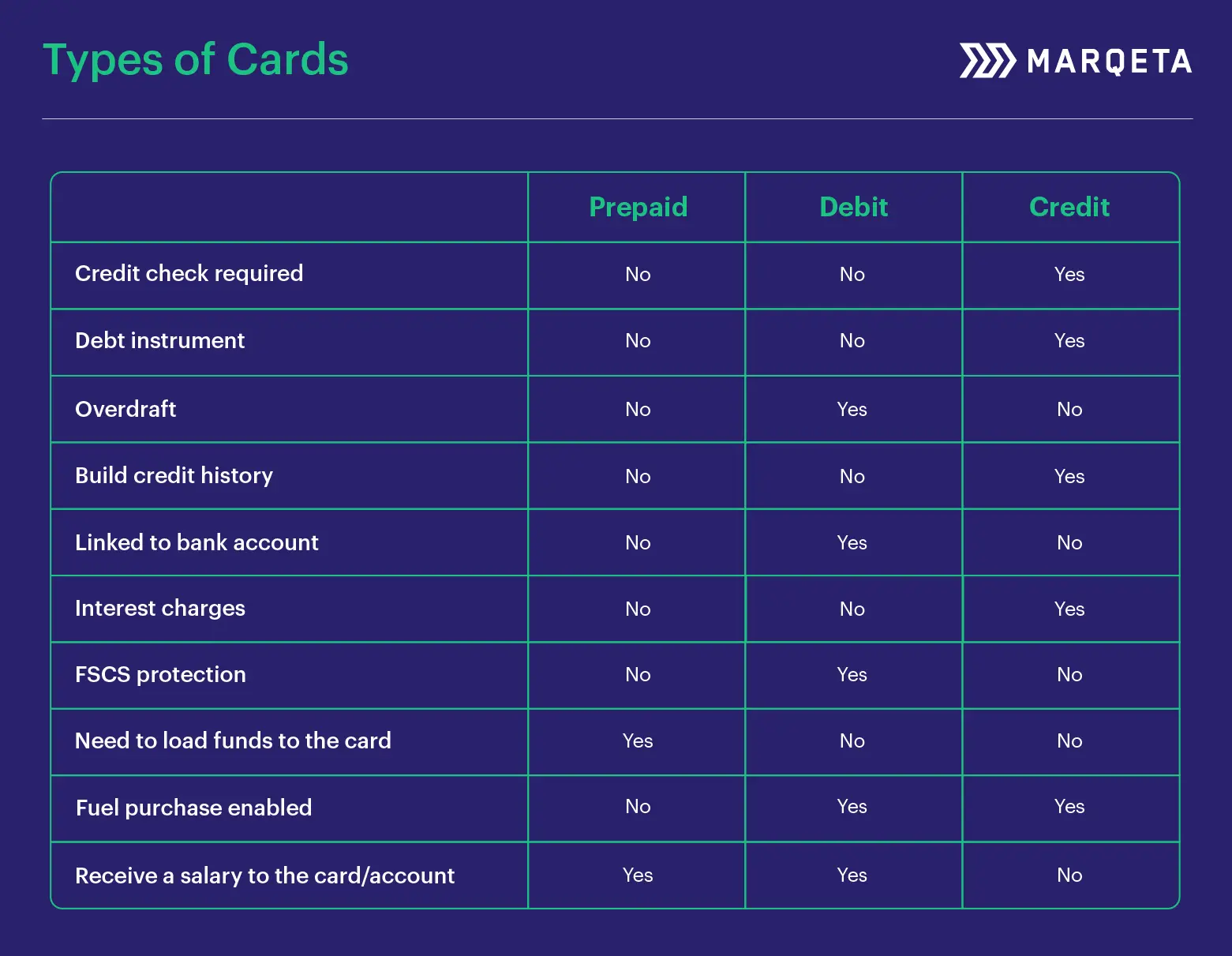Demystifying Cards
Types of cards
On paper, prepaid, debit and credit card propositions can look strikingly similar as almost all of them use some form of authorisation technology to streamline how a customer accesses funds on a card. In fact, the use cases and characteristics of these similar looking cards are actually a lot more nuanced than you think.
It’s also worth noting that different card networks OR schemes (the central payment networks linked to different types of cards e.g. Visa and Mastercard) have specific product requirements for each type of card. Your card proposition will need to take these requirements into account. Plus, these two card networks each have more nuances depending on whether your proposition is for consumer or commercial use. As technology has evolved, the lines are blurring between product boundaries with a prepaid and debit card often indistinguishable for the cardholder, as the user experience is often similar.

Prepaid cards
(Including gift cards and general purpose prepaid cards)
A single or multi-use payment card with money loaded onto it. Used like a debit card to buy things or, where applicable, withdraw cash up to a fixed amount.
Key characteristics
- Mainly used for disbursements, welfare payments, travel money, and gift cards.
- Often a lower barrier is set to identity verification with lower, Know Your Customer (KYC) requirements. KYC is about making sure you can verify your customer’s identity, suitability, and risks of doing business with them. (Due to the reduced risk associated.)
- Flexible – you don’t need a bank account to be directly linked to the card, but you can use it to make standing orders and other recurring payments and pay a regular salary into it.
- Popular with fintechs as a quick route to market, plus prepaid flexibility has evolved since the very early pays of this card type.
- As value is pre-loaded, prepaid is sometimes considered lower risk than debit for the issuer.
- If not part of a major card network (scheme), coverage, and therefore card acceptance, may be limited.
Real-world example
A £100 rebate card is offered by a phone network to consumers purchasing the latest smartphone. The card is loaded in real-time when the cardholder buys a phone, and is no longer usable once they have spent their £100 value.
A £100 rebate card is offered by a phone network to consumers purchasing the latest smartphone. The card is loaded in real-time when the cardholder buys a phone, and is no longer usable once they have spent their £100 value.

Monzo
Monzo started out as a prepaid top up card, offering favourable rates for those travelling abroad and progressive in-app features. It meant they could launch a product before obtaining a banking license and allowed them to gain invaluable early adopters and learnings prior to launching their current account programme.
Debit cards
A payment card associated with a linked bank account that allows you to buy online and in shops, with payments taken directly from that account.
Key characteristics
- Commonly offered by traditional banks but also available from many neo/digital banks for both corporate and consumer use.
- Needs to be linked to an account with an attached IBAN or sort-code/account number.
- Often comes with the ability to make standing orders, direct debits and set up recurring payments.
- Frequently allow customers to have an overdraft by arrangement.
- Don’t require a customer to ‘prefund’ or ‘load’ money onto the card before use as they’re linked to the underlying account.
Real-world example
A digital bank issues a new customer a debit card linked to their current account. The debit card is designed with the bank’s custom logo and can be added into a digital wallet. Worth noting that where a customer’s account is directly connected to a debit card these can be more prone to fraud. A credit card offers a level of protection on transactions as well as a layer of abstraction between a current account and card.
A digital bank issues a new customer a debit card linked to their current account. The debit card is designed with the bank’s custom logo and can be added into a digital wallet. Worth noting that where a customer’s account is directly connected to a debit card these can be more prone to fraud. A credit card offers a level of protection on transactions as well as a layer of abstraction between a current account and card.

Yapeal
Yapeal – Swiss Challenger Bank – an existing Marqeta client and a leader in Switzerland in challenging the existing traditional consumer banking space – Debit (and Vpay) card issued. Read more.
Credit cards
A credit card is a payment card that lets cardholders spend money on credit – it’s like having a loan for the amount you spend using the card.
Key characteristics
- Linked to a revolving line of limited credit determined by the lender’s appetite for risk and the affordability for the customer to repay.
- Require repayments based on the terms of the credit agreement provided by the card programme owner. Typically, minimum monthly payments but sometimes instalment plans.
- In Europe, credit cards offer a marginal benefit over debit card issuers as interchange (the charge levied on an acquirer for each transaction) rates are 10 basis points (bps) higher.
- Usually include other benefits for consumers and businesses such as insurances and loyalty points. These tend to be funded from interchange and the underlying revenues from using credit facilities.

Capital On Tap
Capital on Tap provides credit cards to small businesses in the UK, and have recently launched in Spain and the USA. Their cards are powered by Marqeta.
Physical v Virtual cards
Physical debit, credit and prepaid cards can all take a virtual form and can be used to make online as well as in-app purchases. You can also make purchases through mobile payment services like Apple Pay, Google Pay and Samsung Pay (See tokenised cards for further information). There are a few characteristics of virtual cards that can make them more attractive than just a standalone physical card proposition.
Key characteristics
- Has a 16-digit number, an expiry and a CVV (Card Verification Value: the three- digit number on the back of a card) like physical cards, but is stored on your phone.
- Single-use card numbers generated for each purchase that expire once used
- A negligible physical cost of creating or sending cards to users
- Quick to activate and ready to use in minutes
- No risk of losing a virtual card! (But card security and protection is still paramount)
- Easy to ‘freeze’ if fraud is suspected or the user’s phone is lost or stolen
Real-world example
A multi-use virtual card is issued to an online retail marketplace who uses it to pay multiple suppliers associated with a large order. The card is loaded with funds only once and is terminated after payments are completed successfully.

Twisto
Twisto Issue a virtual card as an option for their customers to utilise as soon as the customer has passed KYC, enabling them to transact online immediately. Twisto customers have the option to order a physical card to follow, and card details can be transferred from the virtual card to the physical card.
Continue reading

Product
Legal
Location
© 2025 Marqeta, Inc. 180 Grand Avenue, 6th Floor, Oakland, CA 94612

